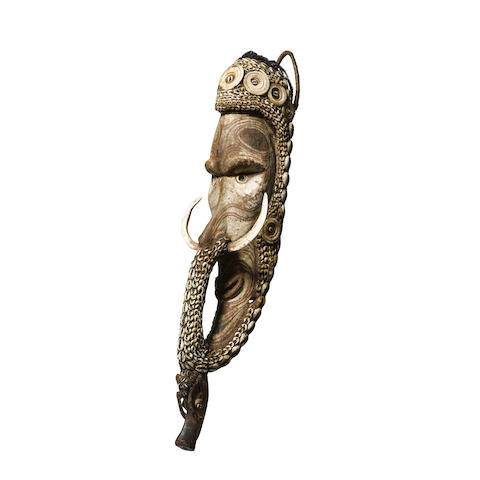Superb Iatmul Mask, East Sepik Provence, Papua New Guinea
mai
height 21 3/8in (54.3cm)
Provenance
Douglas Newton and Kathleen Haven Collection, New York
Wayne Heathcote, London and New York
American Private Collection
Published
Gathercole, Peter, Adrienne L. Kaeppler and Douglas Newton, The Art of the Pacific Islands, National Gallery of Art, Washington, D.C., 1979, p. 320, no. 22.44 (not illustrated)
Exhibited
Washington, D.C., The Art of the Pacific Islands, National Gallery of Art, 1 July 1979 - 14 October 1979
Crispin Howarth notes (Myth and Magic - Art of the Sepik River, Papua New Guinea, National Gallery of Australia, 2015, p. 141), "Mai masks are perhaps the most iconic and identifiable art forms from the Sepik River. They are worn for performances with a group of four dancers on the village's central dance ground in front of the ngeko ceremonial house. Each performer represents a spirit being - two brothers and their two sisters. After the performance, the costume of leaf strips, flowers, feathers and an array of adornments is dismantled and only the wooden mask section is kept in the owner's home.
The performance of the mai is spectacular, as Brigitta Hauser-Schäublin notes:
In actual use it would be embedded in a gorgeous riot of colour, a sea of leaves, flowers, feathers and shells, so that you would have to look twice to recognise it at all. The visually fascinating scene is enhanced by various scents, by the movements, steps and leaps of the masked dancer, the stamping of his feet on the ground which makes the rattles tied round his ankles ring out. ('Mai-Masken der Iatmul, Papua New Guinea, Stil, Schnitzvorgang, Auftritt und Funktion,' in Verhandlungen der Naturforschenden Gesellschaft in Basel, Basel, 1987/88 (1976/77), pp 119-45)"
Masterfully constructed of wood, clay, cowrie and nassa shells, fiber, human hair and boar's tusk in classic elongated form, the artist has captured the mask's mysterious physical presence through multiple attributes, including the sunken eyes inlaid with circular shells, the boar's tusks inserted in each of the flaring nostrils, the boar head element projecting from the bottom and the resplendent curvilinear designs on the face; wear and signs of age to the wood suggest this is a particularly early example, used for a long period of time in situ.
View it on
Sale price
Estimate
Time, Location
Auction House
mai
height 21 3/8in (54.3cm)
Provenance
Douglas Newton and Kathleen Haven Collection, New York
Wayne Heathcote, London and New York
American Private Collection
Published
Gathercole, Peter, Adrienne L. Kaeppler and Douglas Newton, The Art of the Pacific Islands, National Gallery of Art, Washington, D.C., 1979, p. 320, no. 22.44 (not illustrated)
Exhibited
Washington, D.C., The Art of the Pacific Islands, National Gallery of Art, 1 July 1979 - 14 October 1979
Crispin Howarth notes (Myth and Magic - Art of the Sepik River, Papua New Guinea, National Gallery of Australia, 2015, p. 141), "Mai masks are perhaps the most iconic and identifiable art forms from the Sepik River. They are worn for performances with a group of four dancers on the village's central dance ground in front of the ngeko ceremonial house. Each performer represents a spirit being - two brothers and their two sisters. After the performance, the costume of leaf strips, flowers, feathers and an array of adornments is dismantled and only the wooden mask section is kept in the owner's home.
The performance of the mai is spectacular, as Brigitta Hauser-Schäublin notes:
In actual use it would be embedded in a gorgeous riot of colour, a sea of leaves, flowers, feathers and shells, so that you would have to look twice to recognise it at all. The visually fascinating scene is enhanced by various scents, by the movements, steps and leaps of the masked dancer, the stamping of his feet on the ground which makes the rattles tied round his ankles ring out. ('Mai-Masken der Iatmul, Papua New Guinea, Stil, Schnitzvorgang, Auftritt und Funktion,' in Verhandlungen der Naturforschenden Gesellschaft in Basel, Basel, 1987/88 (1976/77), pp 119-45)"
Masterfully constructed of wood, clay, cowrie and nassa shells, fiber, human hair and boar's tusk in classic elongated form, the artist has captured the mask's mysterious physical presence through multiple attributes, including the sunken eyes inlaid with circular shells, the boar's tusks inserted in each of the flaring nostrils, the boar head element projecting from the bottom and the resplendent curvilinear designs on the face; wear and signs of age to the wood suggest this is a particularly early example, used for a long period of time in situ.



